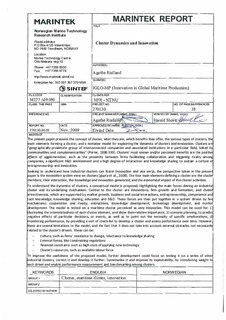| dc.description.abstract | The present paper presents the concept of cluster, what they are, which benefits they offer, the various types of clusters, the
main elements forming a duster, and a tentative mode! for explaining the dynamics of dusters and innovation. Clusters are
"geographically proximate group of interconnected companies and associated institutions in a particular field, linked b
commonalities and complementarities" (Porter, 1998:199). Clusters' most known and/or perceived benefits are the positive
effects of agglomeration, such as the proximity between firms facilitating collaboration and triggering rivalry amon!l
companies, a signiflcant R&D environment and a high degree of lnteraction and knowledge sharing to sustain a culture o
entrepreneurship and innovation.
Seeking to understand how industrial dusters can foster innovation and vice versa, the perspective taken in the presenl
paper is the innovation system view on clusters (gupta et al., 2008). The four main elements definlng a cluster are the cluste1
members, their interactian, the knowledge and innovation generated, and the economical impact of the cluster activities.
tro understand the dynamics of clusters, a conceptual mode! is proposed, highlighting the main forces driving an industrlal
cluster and its underlying mechanism. Central to the duster are innovations, firm growth and formation, and duster
attractiveness, which are supported by market growth, business and social interactions, entrepreneurship, competence and
tacit knowledge, knowledge sharing, education and R&D. These forces are then put together in a system driven by five
mechanisms: cooperation and riva/ry, interactions, knowledge development, technology development, and market
'development. The mode! is tested on a maritime duster perceived as very innovative. This mode! can be used for: 1)
illustrating the interrelatedness of each duster element, and show their relative importance, 2) scenario planning, to predic1
negative effects of particular decisions, or events, as well as to point out the necessity of specific ameliorations, 3)
monitoring performance, by providing a sort of check-list to develop a duster and assess performance over time. However,
there are several limitations to the mode!, and the fact that it does not take into account external obstades not necessaril
related to the cluster's drivers. These can be:
- Culture, such as firms' resistance to change, reluctance to knowledge sharing
- External forces, like constraining regulations
- Financial constrains: such as high costs of applying new technology
- Cluster's resources, such as available labour force
To improve the usefulness of the proposed mode!, further development could focus on testing it on a series of othe1
industrial clusters, correct it and develop it further. Systematise it and improve its exploitability, by introducing weight to each driver and enable performance measurement and benchmarking among dusters. | |
